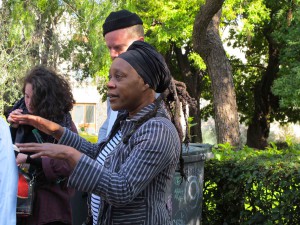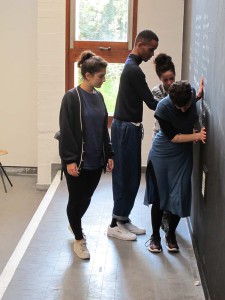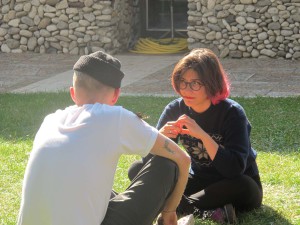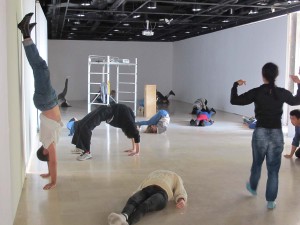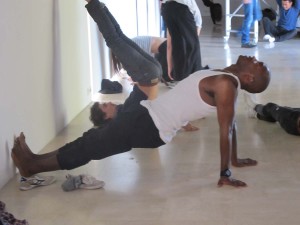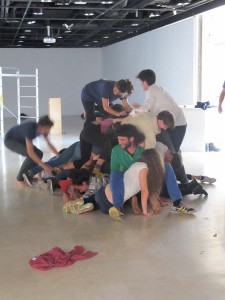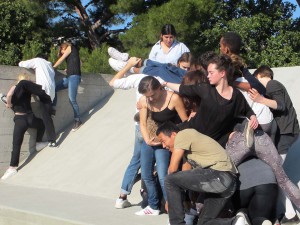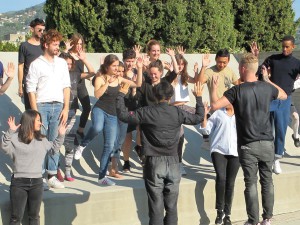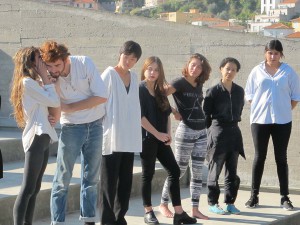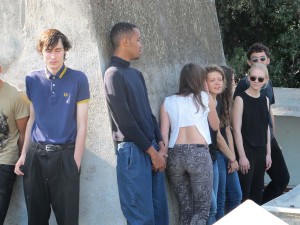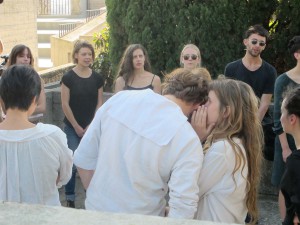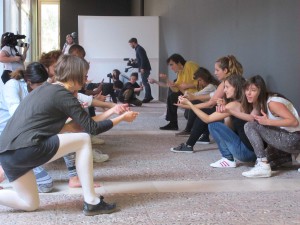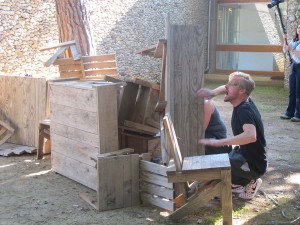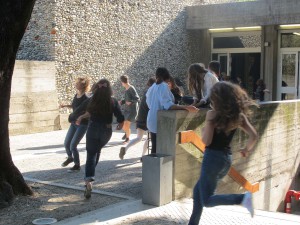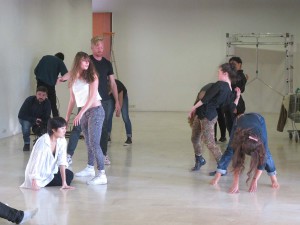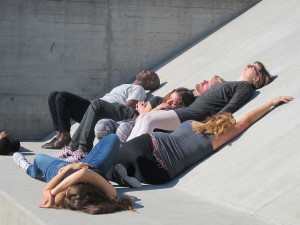Participants
Sonia Boyce Team
Sonia Boyce
Directrice artistique / Artistic Director
Vânia Gala
Performer
Andy Bothwell (Astronautalis)
Performer
Alice Labant
Performer
Michelle Tofi
Directrice de la photographie / Director of Photography
Richard Thomas
Ingénieur du son / Sound Recordist
Basak Bayhan
Second assistant caméra / Second Camera Person
Joe Stone
Troisième assistant caméra / Third Camera Person
Jessica Taylor
Assistante de production / Production Assistant
Maya Bailey
Photographe / Stills Photographer
Villa Arson Students
Sharon Alfassi
Claudio Arnell
Clarisse Charlot-Buon
Johan Christ-Bertrand
Felicia Cleveland-Stevens
Anne-Sophie Duforets
Coline Dupuis
Daisy Gray
Mariana Guedes
Marja Heiskanen
Dong Eeg Kim
Sori Kim
Louis Kiock
Néle Lavant
Paul Lemaire
Marvin M’Toumo
Salomé Martin
Clémence Mauger
Ariidehav Michaud
Lauriane Norgiolini
S Paret
Louise Ronk-Senges
Damien Vongués
Dan Wu
by Richard Thomas, 2015 – 2016
I’m a sound recordist. It’s a job that a lot of people don’t even realise exists, but it’s my job to capture the sync sound for picture as it happens. Most people assume ‘doesn’t the mic on the camera do this?’, they assume that whatever the camera ‘sees’ can be heard- more often than not all the camera mic will pick up will be a distant perspective on the action with high background noise and any movement the camera operator makes will be very present. So, my job is to get microphones closer to the things we want recorded. But in an improvised performance, how do I know what we’re going to want to record?
In my line of work I usually find that planning is really important to getting results; the more I know about what is happening, the more likely I’ll have the tools and personnel to be able to cover and deal with a given situation. However another skill I often have to employ is improvisation: something will be changed at the last moment, someone will neglect to tell me something they didn’t think was relevant and that can make a huge difference to me. I’ll be constantly trying to second guess what’s going to be thrown at me by people whose main concern is what something looks like. I’m also no stranger to improvisation in a more general artistic context- I’ve performed free improvised music for a number of years including work with artists in other contexts, such as dance and visual art. However, in this case I’m improvising more as a technician (which I’m possibly less comfortable with).
My first thoughts when Sonia approached me about this project were if and how the performance would be contained- how many performers there would be? What sort of sound they could be making? What the space would be like? All these questions were open ended so I packed kit for as many situations as I could think of happening and assumed (wrongly) that as the process went on that I’d have more of an idea what was going to happen during the performance and looked into where I could get additional equipment if required locally and the process emerged.
Over the two days before the performance, we started looking around the grounds at Villa Arson and found so many interesting spaces. I really enjoyed the brutalist aesthetic of the architecture, and also how its structure allowed green spaces and plants to grow in sections. I ended up taking far too many photos of the place… I also considered what impact each space would have on me being able to capture the performance, either looking at the amount of space available (the more restricted, the closer I could get microphones on stands and be able to cover the area adequately) and how much background noise there would be.
The day before we also filmed both Andy and Vania working with the students. To be honest, the things both of them were doing with the students were pretty much the scariest things I could imagine dealing with for something like this on a technical level: Andy’s group were doing very low level dialogue – sometimes whispered to each other (and some of his group weren’t the most extrovert of people either), while Vania’s were climbing on top of each other. The reasons for this are that low level dialogue requires close microphones to pick it up, even if you were standing a few metres away you’d struggle to hear what the person is saying, and this is with your brain concentrating on them (see the ‘cocktail party’ or Haas effect) and microphones can’t distinguish individual voices like your brain can. Personal microphones would need to be mounted on the body of the performer and could easily get moved/unstuck and pick up clothing noise easily, so adding movement with climbing on top of each other would limit what they would pick up.
So, when the performance (or “happening”?) began I decided to use as many personal microphones as possible on a variety of performers, mainly so we got a mixture of languages close up and one who said they had an idea based around a song. I also had a stereo microphone setup on a boom to capture a wider perspective. However, I still needed to have a portable rig and it was too late in the day to order in more equipment (let alone enough to have a microphone on everyone…). I had to make sure the microphones and radio transmitters were securely attached to the performers and wouldn’t move, even when doing some physical things. Even after it had started I thought we may stop before moving location, however it didn’t- I was stuck with this setup and had to improvise, running after the performers!
Afterwards, I thought that both through the aesthetic of the buildings and the nature of what the performers were doing that it did have a very 1960s experimentalist feel to it, where I imagine the students of, say Black Mountain College with John Cage and Merce Cunningham may have done similar things- they’re reconsidering what can be considered art, music or performance and not letting things like training determine whether you’re “allowed” to perform like this or not. It’s the sort of environment which encouraged experimentation and allowed performance art to come into its own.
When I’ve worked with Sonia before I know she doesn’t really mind seeing crew and equipment, also I think part of drew me to my job is my ability of avoiding photographs. I do like the fact that the ‘workings’ are revealed (and I’m also doing that here a little).
I’d still avoid being in frame as much as possible, although it’s hard to avoid 3 cameras, there are also a few wireless packs showing, which isn’t too surprising, given some of the movements the performers were doing and their clothes will move. In this case I don’t mind, although feel a little self conscious, but on a different job I would!
Much later, when editing and mixing the audio afterwards I was generally pleased with what I got when cleaned up and re-cut together from all the individual microphones (it was too manic and unpredictable to get a good mix on location): I expect we were lucky, although there were some parts which had issues (Vania was very prominent in the library section and didn’t have a personal mic, I had to use sound from the boom and camera mics to cover this as I couldn’t be next to her all the time) and we didn’t always have the options of a close perspective in some of the whispered sections when performers were not near a microphone.
Everything you hear in the installation was recorded during the performance, ‘live’. There’s an incredibly (biologically) intimate moment which came out of something which would normally be considered ‘wrong’: One of the performers’ microphones gets pushed hard against their chest in the ‘amphitheatre’ section both muffling their voice but also picking up their heartbeat- I edited it in order to make this effect more prominent. It’s the only thing in the piece that pushes the viewer into a more abstract, internalised perspective, although some of the whispered moments are very personal and although captured in a documentary style, doesn’t necessarily fit with that perspective.
The final installation involved playing all the videos back in the same room at once and there’s a wide dynamic range across them, with levels varying between whispers and shouts. We wanted to try and keep the intimacy of the quieter sections in the ‘circle’ and ‘amphitheatre’ videos so that they could be heard, while allowing the full chaos of the ‘library’ and ‘battle’ sections to be brought out. We came up with a sequence so that each of the videos runs for approximately the same time, however I expect it’ll never be quite the same as they’re all running independently, but at least all the loud sections shouldn’t happen at the same time as the quieter ones
